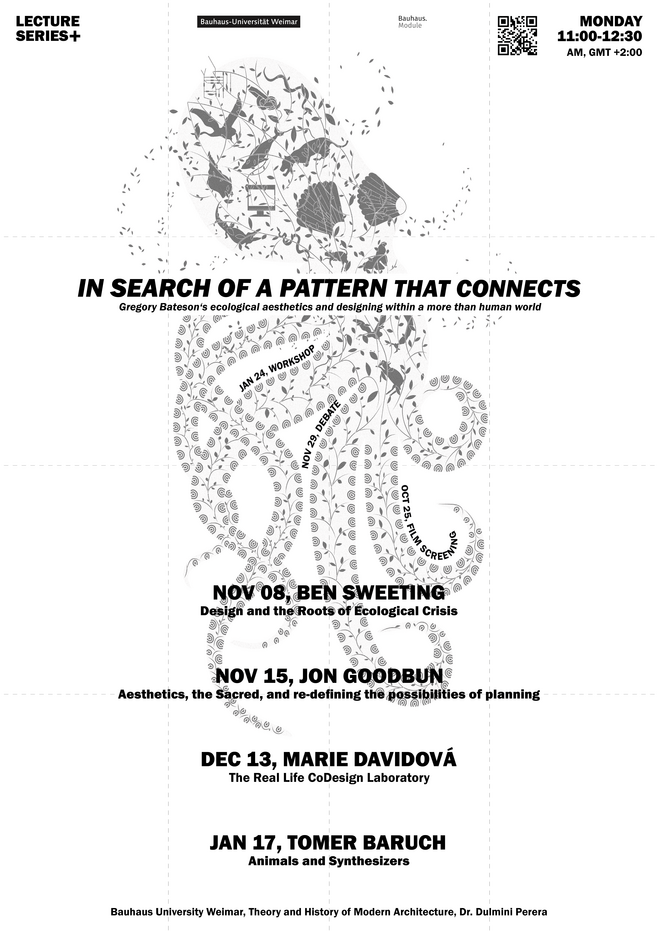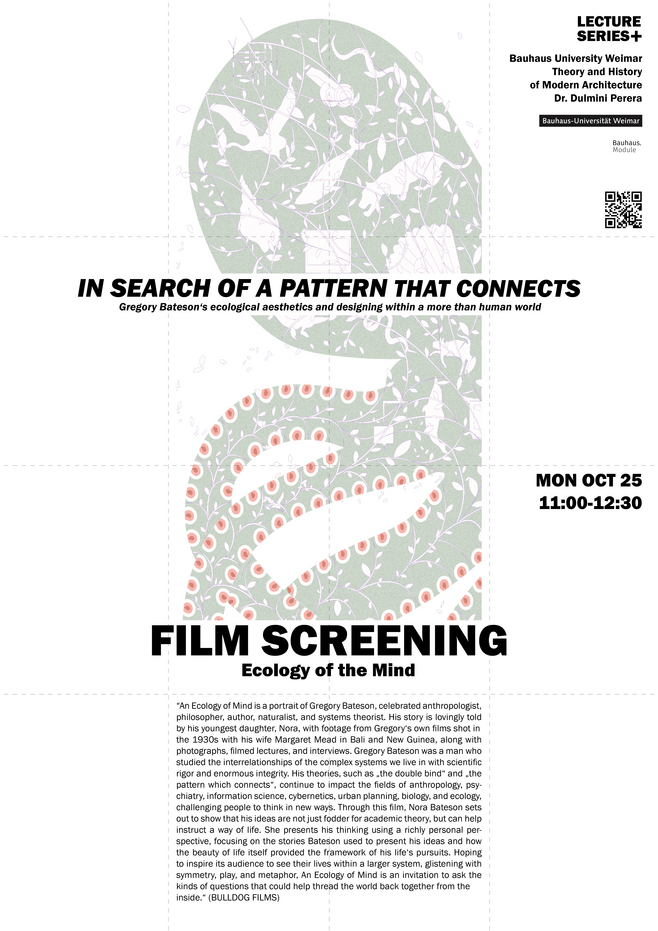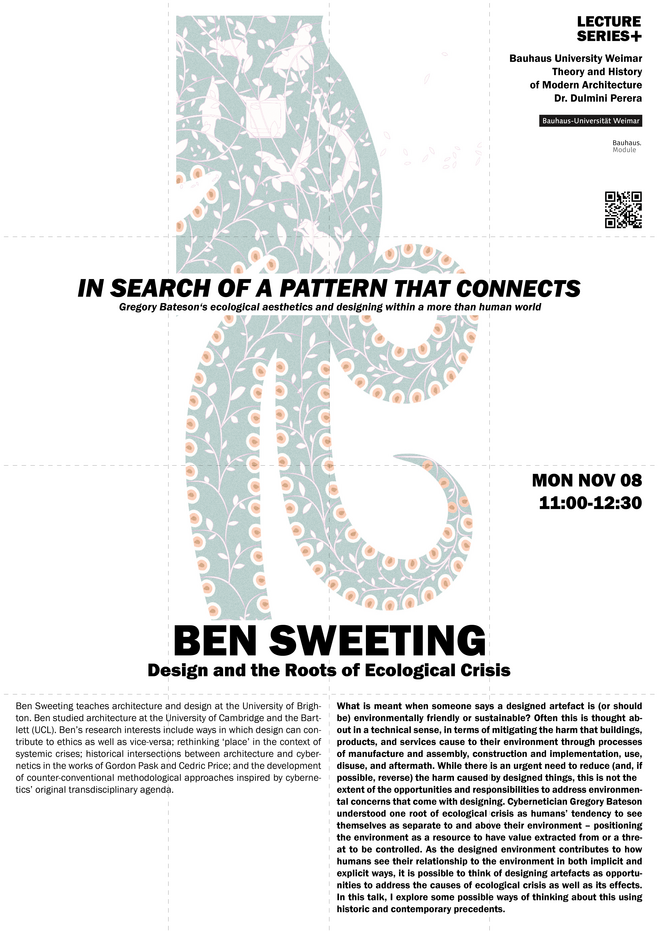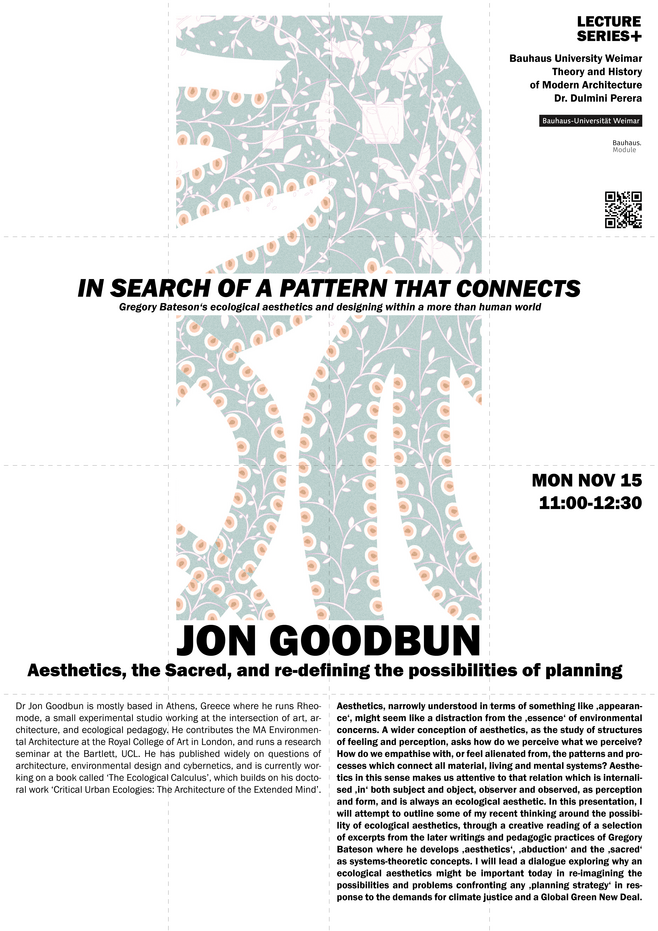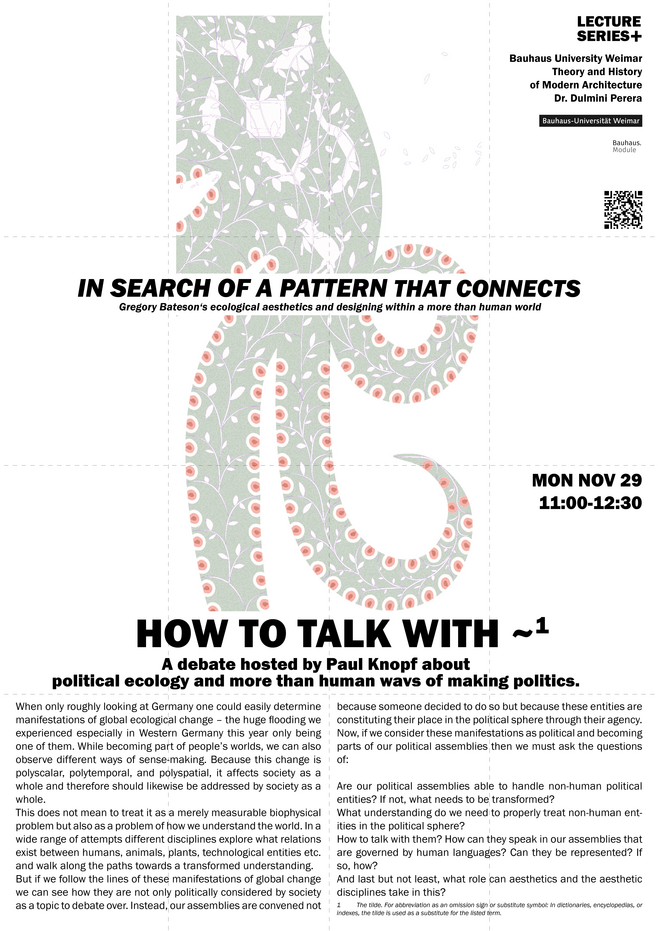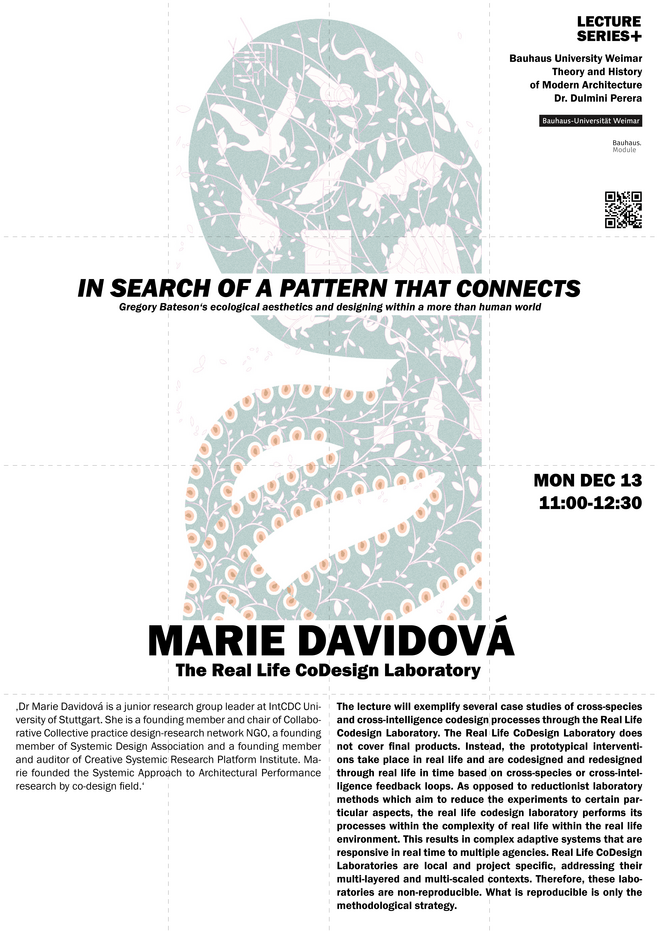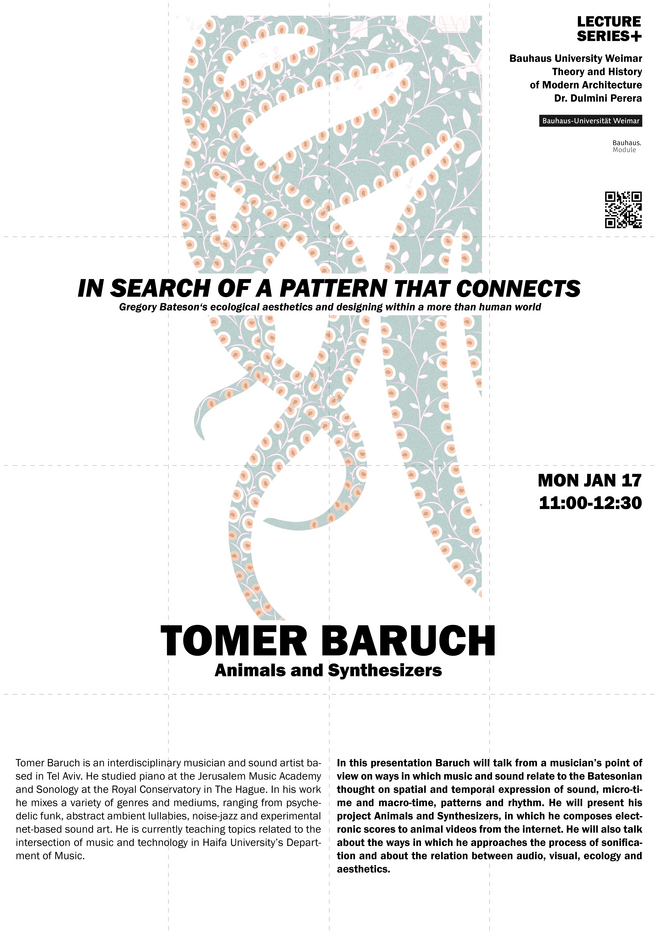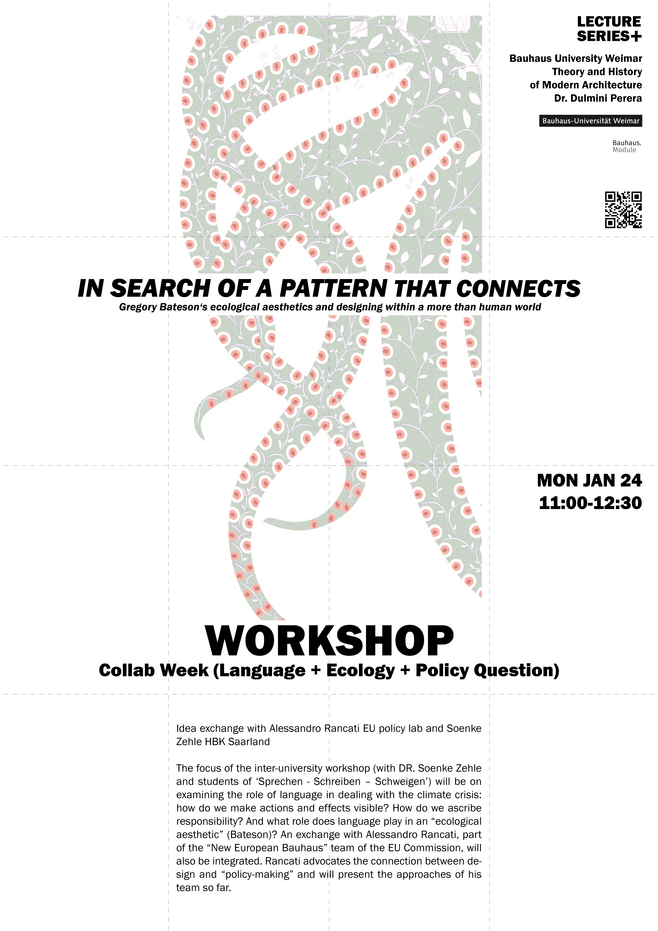Seminar Bachelor ab 3. FS; Master ab 1. FS [Bauhaus.Modul] 2 SWS | 3 ECTS
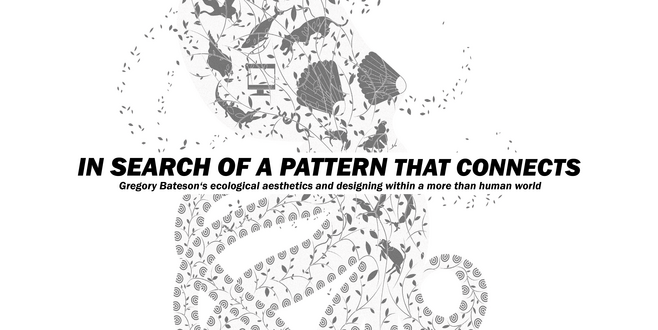
Course introduction
Lehrende: Dr. Dulmini Perera
“What pattern connects the crab to the lobster and the orchid to the primrose and all of them to me? And me to you? And all six of us to the amoeba in one direction and to the back-ward schizophrenic in another?” (Bateson, 1978) What pattern connects this question to you, me, and us as we work in times of ecological crisis, a time of many proposals such as Green New Deals and a call for a New Bauhaus?
If you are curious about these questions, join us this semester as we embark on a semester-long exploration of the pattern that connects as it appears within the work of Gregory Bateson. The pattern that connects is another term for how Bateson came to redefine 'aesthetics' to encompass the complexity of a more than human world. Bateson was critical of the 1960-70s discourses on 'patterns' emerging across disciplines from information sciences to the design sciences, which used the notion of a 'pattern language' in a technocratic manner to make the environment more manageable. He reframed 'patterns' within a more ecological, aesthetic, and spiritual discussion that acknowledged the systemic complexity of living systems that environmental management models could not fully capture. Bateson pointed out the wrong ways in which design sciences used the notion of the survival of the fittest that sets a competitive relationship between the organism vs. environment, suggesting that the unit of survival was the 'relation' between the organism and environment. He sought to address the complexity of this unity by placing the questions of aesthetics in a 'communicational order,' in contrast to his predecessors of the western world, who framed aesthetics as a quality primarily dependent upon the perceiving human subject. By framing aesthetics as a form of meta- communication, ecological aesthetics denotes a participatory process between the human and non-human systems (animal, institutional, technological) that characterize the living world. He reconfigured how participation, power, system, learning, and flexibility can be reframed as part of a design discussion and an ecological discussion.
In this seminar, we will review the critical texts related to Bateson's concept of ecological aesthetics and engage in conversations with guest researchers (Dr. Jon Goodbun, Dr. Ben Sweeting, Dr. Marie Davidova, Tomer Baruch) who have extended these ideas to their respective practices in design politics, ethics, and design material prototyping, electronic music. We will entertain the possibility of how a better understanding of 'Batesonian aesthetics' can provide an alternative framework for articulating a better design approach towards a more than human world and reframe this concept in ways that are accessible to other designers and stakeholders of the design process.
Course language: English/Deutsch
All lectures will be held in English. The personal projects can be conducted in English or German.
Course Format: mixed between lectures and activities
1 Film screening (in presence) + 4 guest lectures (Virtual/open to public) + 2 reading sessions (in presence) + debate + workshop + 3 individual consultations for project
Final Submission (output):
Based on the readings, discussions, and guest presentations, the participants are encouraged to unpack what Batesonian 'ecological aesthetics' and its ethical, social, political implications can mean in designing within the current ecological crisis via a creative response. The creative response should be presented via a video of a maximum of 10 min, which can take the form of recording a story, a poem, an artwork, a record of a personal building project, or a manifesto developed within the semester. The objective is to make the notion of 'ecological aesthetics' more accessible to a broader audience.
The project videos and lecture discussions would be edited and compiled as a playlist and would be made available to the greater public.
If you are interested in taking part in the course and have questions,
contact dulmini.perera[at]uni-weimar.de
Course Programme:
Mondays 11.00-12.30 PM unless otherwise indicated
18.10 Introduction to the project (online)
25.10 FILM SCREENING (Weimar)
01.11 Reading and Reflection (Session 1: Crisis in the Ecology of Mind and Patterns)
08.11 Lecture 01 (Dr. Ben Sweeting)
15.11 Lecture 02 (Dr. Jon Goodbun)
22.11 Student final project idea group presentation and discussion
29.11 STUDENT DEBATE, Organized by Paul Knopf (Weimar)
06.12 Individual meetings
13.12 Lecture 03 (Dr.Marie Davidova)
20.12 HOLIDAYS
27.12 HOLIDAYS
03.01 Individual meetings
10.01 Reading and Reflection (Session 2: Ecology questions and limits of language)
17.01 Lecture 04 (Tomer Baruch)
24.01 WORKSHOP-COLLABORATION (Language*ecology+policy question)
Idea exchange with Alessandro Rancati EU policy lab and Soenke Zehle HBK Saarland
31.01 Final project presentation
15.02 Final submission date for student projects (after revisions)
Projekt Callaborators:
Jon Goodbun, Ben Sweeting, Marie Davidova, Tomar Baruch
Workshop collaborators: Dr.Soenke Zehle, Alessandro Rancati, EU Policy Lab
Student collaborators: Leonie Link, Sam Koh, Paul Knopf
Detailed Programme Information
Oct 25, Film Screening, Ecology of the Mind
Nov 11, Ben Sweeting, Design and the Roots of Ecological Crisis
Join us: https://tinyurl.com/s2r3fuut
Nov 15, Jon Goodbun, Aesthetics, the Sacred, and re-defining the possibilities of planning
Join us: https://tinyurl.com/ytkb8x
Nov 29, Debate, How to talk with ~1
Location: Belvederer Allee 1 A, student. Arbeitsraum 102, nur mit 3G
How to talk with ~[1]
Especially the last years have made obvious what long was known to the scientific community and heavily communicated: We are living in the time of global ecological change.
When only roughly looking at Germany one could easily determine manifestations thereof – from the huge decrease of insect biomass affecting agriculture over the death of extensive forest areas due to a combination of drought and bark-beetle in 2019 and 2020 which correlates with a bad state of German forests in general as the Waldzustandsbericht 2020 has shown to the huge flooding we experienced especially in Western Germany this year not to mention the still ongoing pandemic.
Here, two things become evident: First, these changes are not mere messengers of global ecological change but manifestations thereof. Global ecological change has made it from scientific texts with their graphics and diagrams and from the periphery of eurocentric perception to the reality of European people’s lives. As it has become directly perceivable it also has become part of their worlds. Logically, we can observe different ways of sense-making.
Additionally, a shift in mentality and focus on the role of non-human beings occurred and has become more and more insistent in the last years. This also correlates with the reconsideration and contestation of the subject-object-dichotomy. In a wide range of attempts different disciplines explore what relations exist between humans, animals, plants, technological entities etc. Exemplarily, one could look into the engagement with the ecology of the city: The city is no longer considered as a cultural hub of humans and built environment but as a naturecultural cyborg, a net or pattern of relations between different interactive entities that we used to call tree, bird, technology etc. And the city itself is therefore only a dense entanglement in the whole system we call world. Nevertheless, these debates still fall far short of being part of public concern.
And second, global ecological change fundamentally differs from regional environmental problems which only used to be singularly addressed by environmental organizations and local activists. Because global change is polyscalar, polytemporal, and polyspatial and a state of Earth’s system with all its interdependence and feedback loops, it cannot be narrowed down to the regional but affects society as a whole and therefore should likewise be addressed by society as a whole. Still, we cannot treat global ecological change merely as a measurable biophysical problem but also as a problem of how we understand the world.
Now, if we take a look again at the manifestations of global change we can see how they are not only politically considered by society as a topic to debate over. Instead, our assemblies are convened not because someone decided to do so but because these entities are constituting their place in the political sphere through their agency.
So, if we consider these manifestations as political and becoming parts of our political assemblies then we must ask the questions of:
Are our political assemblies able to handle non-human political entities? If not, what needs to be transformed? What understanding do we need to properly treat non-human entities in the political sphere?
How to talk with them? How can they speak in our assemblies that are governed by human languages? Can they be represented? If so, how?
And last but not least, what role can aesthetics and the aesthetic disciplines take in this?
[1] The tilde. For abbreviation as an omission sign or substitute symbol: In dictionaries, encyclopedias, or indexes, the tilde is used as a substitute for the listed term.
Dec 13, Marie Davidová, The Real Life CoDesign Laboratory
Join us: https://tinyurl.com/3fx8cbby
Jan 17, Tomer Baruch, Animals and Synthesizers
Join us: https://tinyurl.com/2b2662b3
Jan 24, Workshop, Collab Week (Language + Ecology + Policy Question)
Organisatorisches
Beginn: 18. Oktober 2021
Zeit: montags, 11 Uhr
Ort: B1 A, R. 102 nur mit 3 G-Regel/Hybrid

